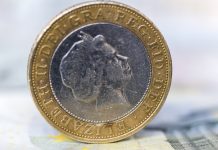The pound tumbled versus the US dollar for much of the previous week. The pair dropped 0.8% snapping a six-week winning streak. The pound fell from the week’s open of US$1.3202 to a low on Friday of US$1.3044. The pound kicked off the new week, slightly weaker versus the dollar.
| What do these figures mean? |
|---|
| When measuring the value of a pair of currencies, one set equals 1 unit and the other shows the current equivalent. As the market moves, the amount will vary from minute to minute.For example, it could be written:1 GBP = 1.28934 USDHere, £1 is equivalent to approximately $1.29. This specifically measures the pound’s worth against the dollar. If the US dollar amount increases in this pairing, it’s positive for the pound. Or, if you were looking at it the other way around:1 USD = 0.77786 GBPIn this example, $1 is equivalent to approximately £0.78. This measures the US dollar’s worth versus the British pound. If the sterling number gets larger, it’s good news for the dollar. |
Sterling moved southwards versus the dollar last week after Parliament failed to vote on a new direction for Brexit. Instead, the House of Commons voted to send the UK Prime Minister back to Brussels to attempt to renegotiate the Irish backstop. This is the most contentious part of the Brexit deal.
The EU have been clear over the past few months that they are not prepared to re-open Brexit deal negotiations. Brussels repeated this same message just last week. Theresa May could have a challenge convincing the EU to start talking again. The whole time that the PM is going in circles the chances of a no- deal Brexit are increasing as the clock ticks down to March 29.
| Why is a “soft” Brexit better for sterling than a “hard” Brexit? |
|---|
| A soft Brexit implies anything less than UK’s complete withdrawal from the EU. For example, it could mean the UK retains some form of membership to the European Union single market in exchange for some free movement of people, i.e. immigration. This is considered more positive than a “hard” Brexit, which is a full severance from the EU. The reason “soft” is considered more pound-friendly is because the economic impact would be lower. If there is less negative impact on the economy, foreign investors will continue to invest in the UK. As investment requires local currency, this increased demand for the pound then boosts its value. |
As Brexit concerns dominate political headlines, the negative impact of Brexit on the UK economy has also been evident. Last week, data showed UK manufacturing sector activity slowed in January by more than what analysts had been expecting. Car maker Nissan has also decided to cancel the production of a new car model at its Sunderland factory. This is a warning sign of what a no deal Brexit could do to the UK economy.
Today investors will continue watching Brexit headlines. UK Construction activity data could also warrant some attention.
Dollar Supported By Strong Labour Market
The dollar was holding steady as investors continue digesting Friday’s jobs report and look ahead to a week packed with Fed policy makers speeches.
The US jobs report saw 304,000 new jobs created in January, smashing analysts expectations of 166,000. This tells the market that the US government shutdown had little impact on the US labour market. However, US wages increased by just 0.1% month on month which was disappointing but didn’t stop the dollar from moving higher.
| How does the non-farm payroll (NFP) affect the US dollar? |
|---|
| It works like this, when there is low unemployment and high job creation, the demand for workers increases. As demand for workers goes up, wages for those workers also go up. Which means the workers are now taking home more money to spend on cars, houses or in the shops. As a result, demand for goods and services also increase, pushing the prices of the good and services higher. That’s also known as inflation. When inflation moves higher, central banks are more likely to raise interest rates, which then pushes up the currency’s worth. |
Just as recently as 6 weeks ago the Fed was indicating that it would hike rates across 2019. Last week the Fed informed the market that it was now prepared to take a more patient approach to tightening monetary policy. Investors will be keen to hear more about the Fed’s change in stance. A continuation of the dovish tone could send the dollar lower.
This publication is provided for general information purposes only and is not intended to cover every aspect of the topics with which it deals. It is not intended to amount to advice on which you should rely. You must obtain professional or specialist advice before taking, or refraining from, any action on the basis of the content in this publication. The information in this publication does not constitute legal, tax or other professional advice from TransferWise Inc., Currency Live or its affiliates. Prior results do not guarantee a similar outcome. We make no representations, warranties or guarantees, whether express or implied, that the content in the publication is accurate, complete or up to date. Consult our risk warning page for more details.
This article was initially published on TransferWise.com from the same author. The content at Currency Live is the sole opinion of the authors and in no way reflects the views of TransferWise Inc.





